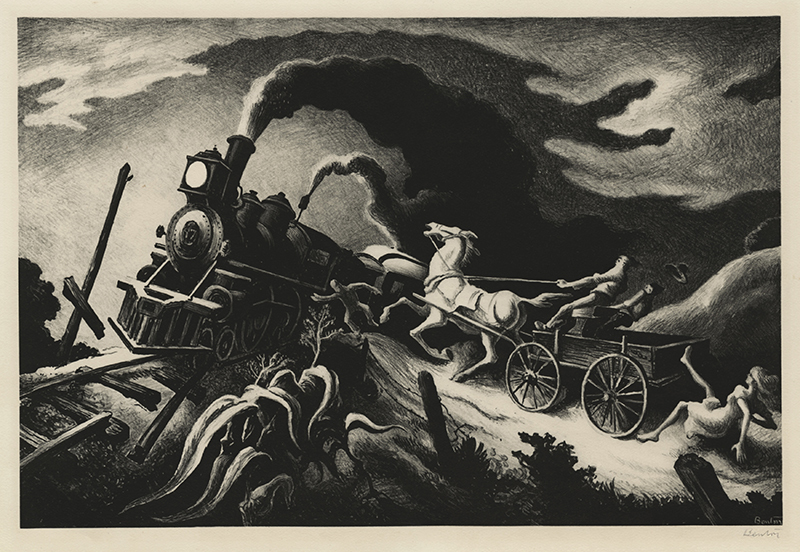
19th, 20th & 21st Century Fine Prints
707-546-7352 · fax 707-546-7924 · web: www.annexgalleries.com · email: artannex@aol.com
Wreck of the Ol’ 97 by Thomas Hart Benton

Wreck of the Ol’ 97
Thomas Hart Benton
Wreck of the Ol’ 97
Thomas Hart Benton
1889 - 1975 (biography)"My first pictures were of railroad trains. Engines were the most impressive things that came into my childhood. To go down to the depot and see them come in, belching black smoke with their big headlights shining and their bells ringing and their pistons clanking, gave me a feeling of stupendous drama, which I have not lost to this day." -- Thomas Hart Benton.
The Wreck of the Old 97 was an American rail disaster involving the Southern Railway mail train, officially known as the Fast Mail (train number 97), while en route from Monroe, Virginia, to Spencer, North Carolina, on September 27, 1903. Due to excessive speed in an attempt to maintain schedule, the train derailed at the Stillhouse Trestle near Danville, Virginia, where it careened off the side of the bridge, killing 11 on-board personnel and injuring seven others. The wreck inspired a famous railroad ballad, which was the focus of a convoluted copyright lawsuit but became seminal in the genre of country music.
Benton commented on this image: "Famous 'folk song' of the '20s. Not a 'true' folk song but oneof the syntheses of the time based on an old folk tune. Drawing made in winter of 1926-27 - lithograph made in early 40s painting of this subject was purchased by Sears Roebuck Co and a print of it was circulated by the firm during the 40's and early 50's. Don't know where the painting is now." Benton's print captures the dramatic action of the song although he changed the locale to reflect the midwest landscape of his native Missouri and replaced the trestle with broken track in front of the speeding engine. A figure rushes to warn a horse and wagon that is being reactively controlled. The driver uses all of his weight to pull back on the reins, shifting the momentum of the wagon and throwing a woman passenger to the ground.
Thomas Hart Benton was born on 15 April 1889 in Neosho, Missouri. He was named after his great grandfather, Thomas Hart Benton, who was a five-term senator. His father, Maecenus Benton, was a lawyer and United States representative so, in his formative years, the young Benton spent time in Washington, D.C. and southern Missouri. He dropped out of school at seventeen years old to work as a cartoonist for the Joplin American newspaper but his father enrolled him in the Western Military Academy in Illinois in 1906 before consenting to allow him to enter the School of the Art Institute of Chicago the following year. In 1908, Benton studied at the Académie Julian where he met the American modernist artist Stanton Macdonald-Wright and came under his influence. He explored Macdonald-Wright's synchromistic style of abstract painting and Benton's paintings from as late as the mid 1920s often exhibit this influence.
Benton returned to the U.S. in 1911 settling in New York. During the First World War he created illustrations for a catalogue of ships and military equipment while stationed at the naval base in Norfolk, Virginia. After the war, Benton went back to New York and became an influential teacher at the Art Students League where he taught and became a mentor and friend to a young Jackson Pollock. Due to the illness of his father, he headed back to Missouri to visit but settled permanently in Kansas City, Missouri in 1935. By this time, he had completely broken away from modernism and his style was naturalistic and greatly influenced by the Spanish painter El Greco.
Benton painted a number of monumental murals in the 1930s including mural cycles for the New School of Social Research, the Whitney Museum of American Art, the New Britain Museum of American Art, and the 1933 Chicago Worlds Fair, and in the process became known as one of the most innovative mural painters in America. His politics were leftist leaning and his imagery depicted the working class in rural America and his painting and murals were often social commentaries on injustices. Benton was among the three leading regionalist painters, which also included Grant Wood and John Steuart Curry. In Kansas City, he taught at the Art Institute until 1941 and, in 1936, he completed a mural for the Missouri State Capitol.


